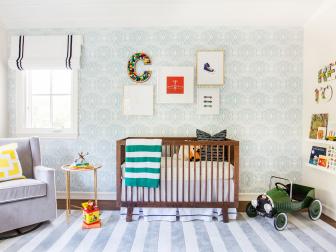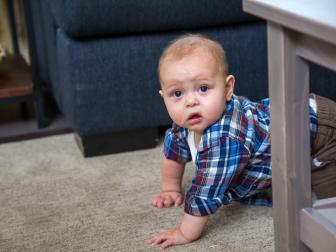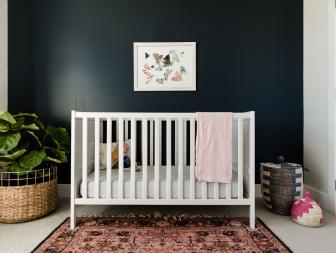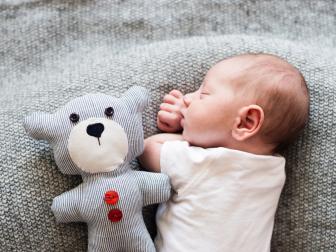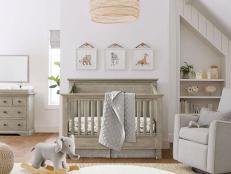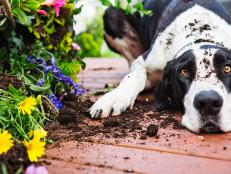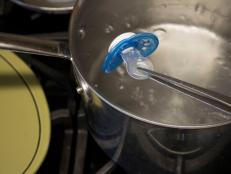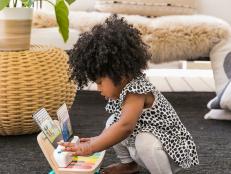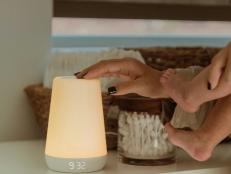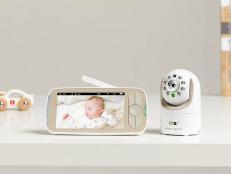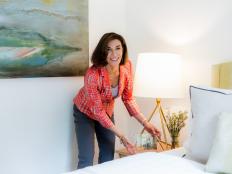How to Prepare Your Home for a Baby
Expecting an addition to your family? Consider safety, storage and comfort to get your home ready for a baby.
Nine months may seem like plenty of time to prepare your home for the arrival of a baby. But if you find yourself at week 35 and you’ve barely had time to buy a crib, let alone design a nursery, you are not alone. Transforming your home from a grown-up zone into a baby-friendly domicile can be a daunting undertaking. Here are some basic steps to help get you started.
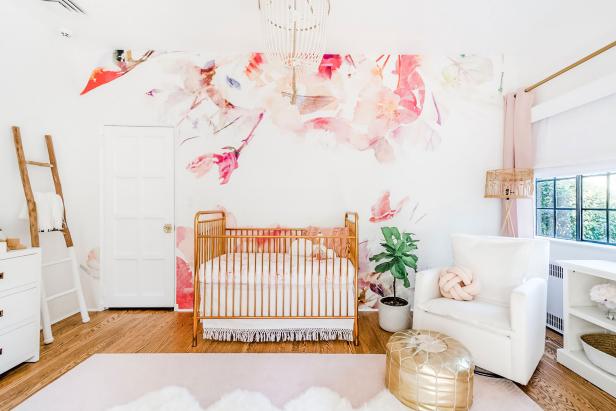
Curated Nest Interiors
As a parent, you’ll spend nearly as much time in your nursery as your baby. Design a space that makes both you and your little one happy and comfortable.
Declutter and Rearrange
Your home is about to become a repository for baby gear and toys that will take up precious space, so it’s worth spending some time purging, decluttering and rearranging, especially if you live in a space-challenged home.
Anticipate the baby items that will have the greatest impact on space, then reorganize rooms to accommodate the items. Relocate accent tables or chairs to make way for items with large footprints, such as a baby swing or play pen. If you plan for baby to sleep in your bedroom, clear out space for a bassinet near your bed or make sure your bed is safely outfitted for co-sleeping. Karen Aronian, a design expert who specializes in educational spaces, points out that even small details, such as throw pillows on the bed or sofa, may need to be stowed away to make space for nursing pillows and body pillows.
20 Newborn Essentials and Must-Haves for New Parents
Don't let your registry get out of control with every product ever designed for infants. We've narrowed it down to the 20 absolutes you need before bringing your little one home.
Optimize Your Existing Decor
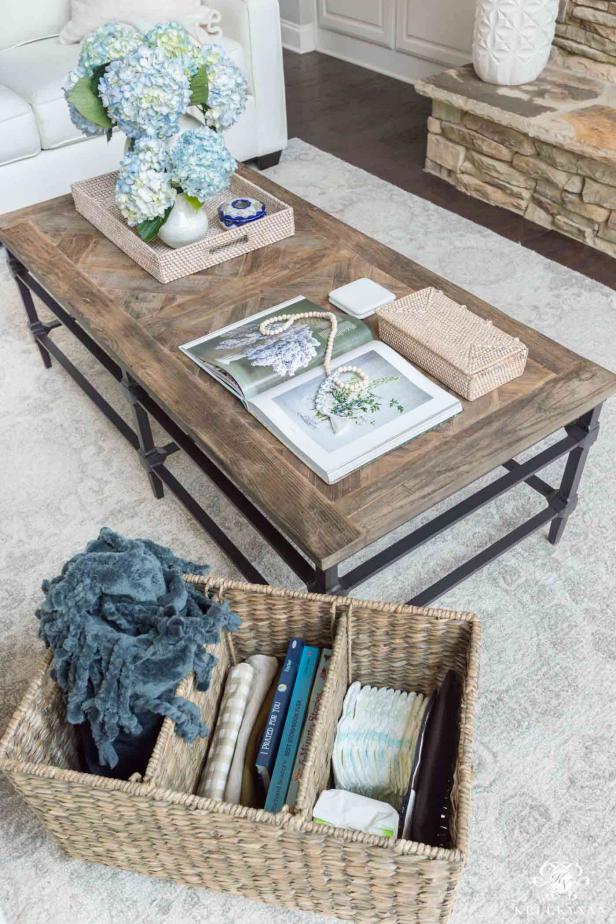
Kelley Nan
Conceal baby items in the living room using stylish storage baskets.
If you don’t want your house to look like it’s been overtaken by baby gear, think about ways to integrate or conceal baby items. Design blogger Kelley Nan stocked her living room with diapers, wipes and baby books — and strategically stowed them in tasteful storage baskets for complete concealment. A stylish storage chest can hide toys while also making them easy to transfer between rooms. In lieu of a play pen or play mat in the living room, designate an area of rug for your baby. Babies love to explore with their senses, so a textured carpet or colorful floor cushions can keep them engaged. Just be sure to clear the area of safety hazards, especially if your baby is starting to crawl.
Erin Coren, co-founder of Curated Nest Interiors, emphasizes that not every room needs to look like a playroom. “Instead, it's best to have a few key play areas in eyesight of where you spend a lot of time,” says Coren.
Nursery for Baby — and You
When designing your child’s nursery, remember that you may be spending nearly as much time in this room as your baby, whether it’s for diaper changes, nursing or middle-of-the-night soothing. So while it’s important to keep your baby’s basic needs in mind, a nursery should also be a place that makes you happy and comfortable.
First, decide where baby will sleep in the nursery. Place the crib away from items that might pose a safety hazard, such as cords for blinds. You will also need a changing station with a nearby diaper pail and a chair that you can comfortably sit on while nursing or reading to your baby. If you don’t have space for a bookshelf, Ashley Murphy of NEAT Method recommends keeping books in a pretty basket or bin. This prevents disheveled piles of books from accumulating on the floor.
Coren reminds parents to consider the proportions of all nursery furniture. “As a short mama, I had to make sure the crib rail was low so it was easy to pick up the baby without leaning over too far,” Coren says. “These little details matter for your comfort.”
As far as decor is concerned, don’t feel beholden to traditional baby themes like alphabets and animals. Pick decor that is suitable for a nursery but also appealing to you, the parent. “The first few years of this room is yours to design as you please before you enter opinionated toddlerhoods and threenagers,” says Coren. “If you want a theme that is special for you, go for it.”
Beautiful Baby Rooms 40 Photos
When that nesting instinct kicks in, it's time to create the ultimate haven for your newborn. Whether you want to bring your little one home to a charming parade of animals, a minimalist abode or a purely elegant retreat, we've got you and baby covered.
Gear Up
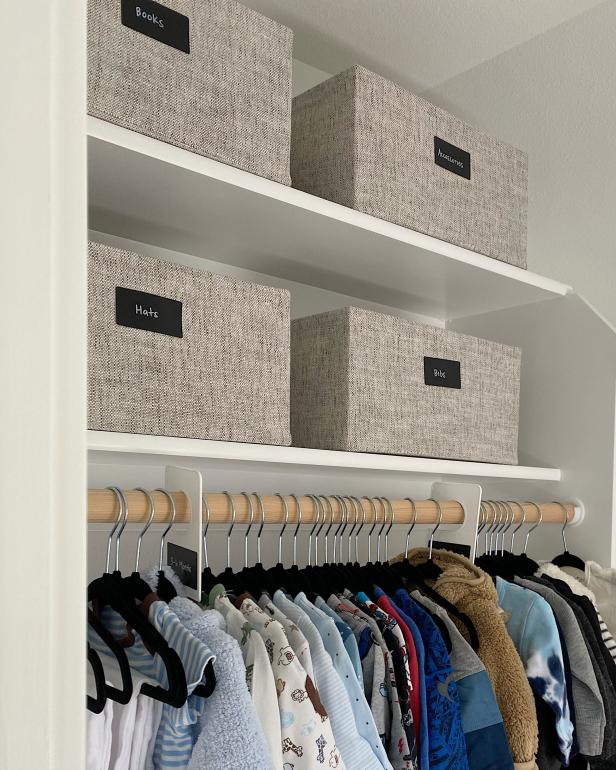
NEAT Method
Store items your baby hasn't grown into yet in labeled bins so you can easily find them when needed.
Every baby is different, so you will probably end up experimenting with various bottles, swaddles and other items before figuring out which ones work best for you and your baby. When shopping for essentials, think about where baby will sleep in the early months and as he or she grows older, whether it’s a co-sleeper, bassinet or traditional crib. Also consider where you plan to put your baby while you are cooking, cleaning, showering or working. Carriers are ideal for keeping baby close, while a baby swing, bouncer or play mat will buy you some time to accomplish tasks without the extra load.
Since it’s hard to predict which brands or products will work best for your baby, Aronian recommends getting as much secondhand gear as possible and passing along what you don’t need. Whether your gear is new or secondhand, it’s helpful to organize and store it by age. Marissa Hagmeyer, co-founder of NEAT Method, organizes surplus baby items with bins and hangers labeled by age or category. The labels make the items easily accessible as baby grows.
Baby-Proof the Home
Take a careful look at each room of your home and assess how to incorporate safety precautions. “Our best suggestion is to get down to your baby’s level and see what looks enticing and make sure it’s safe,” says Coren. Use outlet covers to keep little fingers out of sockets. Childproof locks are helpful for barring babies from cabinets or drawers with hazardous cleaning supplies or sharp objects. Bolt dressers to the wall to prevent them from tipping over and use baby gates to keep babies out of areas that are not child-friendly, such as a home office or a staircase. Coren recommends hiring a babyproofing service, such as Baby Bodyguards, to ensure that your home is as safe as possible by the time baby arrives.
How to Baby Proof Your Home
Babies and toddlers can get into a lot of places you didn't think possible. Make sure your home is safe and sound for your little ones.
Gussy Up the Guest Room
If you have a spare room, it might get more use once baby arrives. Relatives will come to visit the baby, and you may take occasional retreats in the guest room for a chance to sleep through the night. “Many parents will want to decamp to these quiet zones when they’re off duty to catch a wink,” Aronian says. For this reason, you may want to make the room feel more hospitable, especially if it currently serves as a storage space. Consider upgrading the bedding and outfitting the room with a white noise machine, eye masks, earplugs or even aromatherapy.
More Tips for New Parents
20 Nursery Design Trends We're Loving 20 Photos
These baby room trends are hot, hot, hot. Find out why, and get tips to bring the looks to life in your own home.
Our 85 Best Baby Shower and Gender Reveal Party Ideas 85 Photos
Prepare to go gaga over stylish decor, sweet gifts and bump-approved bites.
16 Adorably Unique Ways to Capture Baby's First Year 16 Photos
Snapping creative photos of your little one is easier than you think.







